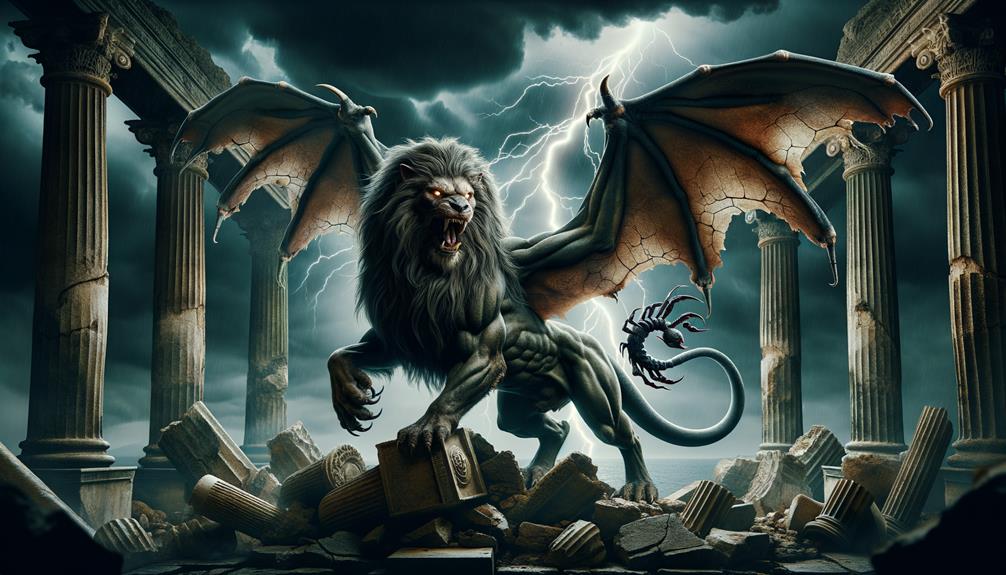Just as an archaeologist uncovers treasures hidden in the sands of time, I have, too, immersed myself in the depths of ancient and medieval literature to bring to light the legend of the Manticore. This mythical beast, sporting a human-like face, body of a lion and a poisonous tail, has been a captivating topic since its initial introduction by the Greek doctor, Ctesias. The transformation of the Manticore's image across cultures and time, along with its consistent presence in today's fantasy literature and games, provides fascinating insights into our collective intrigue with the terrifying and the unknown. In this discussion, we'll dissect the myth, trace its roots, examine its various representations, and delve into its cultural importance. So, let's get right into it, shall we? Let's start unraveling the mysterious tale of the Manticore.
Manticore's Physical Attributes
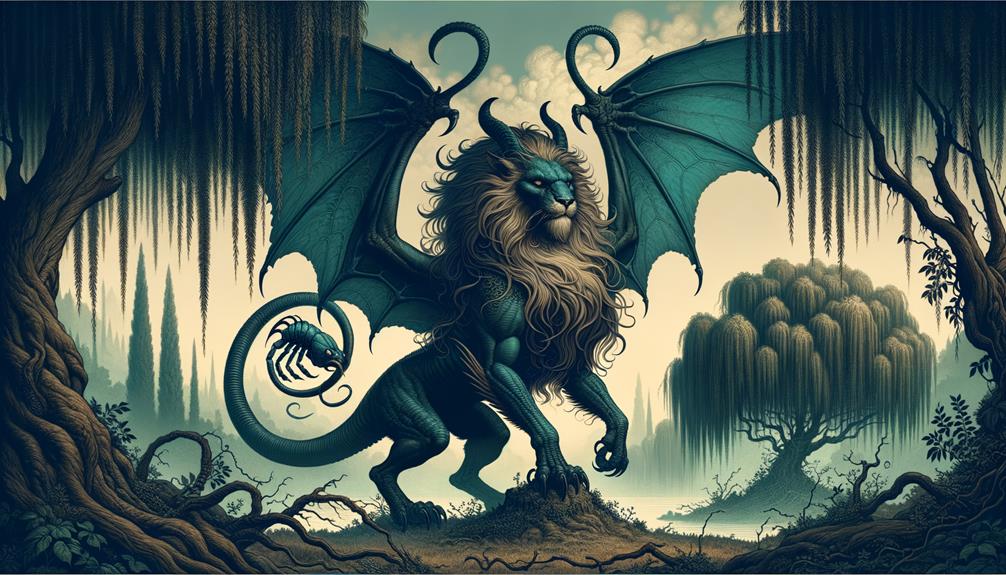
Let's chat about the manticore, an intriguing mythical creature with an incredible blend of human and beast-like features. One of its stand-out characteristics is a human-like face set on a lion's body, cloaked in deep red fur. Its eyes, a striking shade of blue, are as captivating as they are intimidating. And let's not forget its tail, which is designed like a scorpion's – a lethal weapon in its own right.
This creature, which resembles a lion, is not just visually impressive but also incredibly deadly. Its mouth is filled with three rows of sharp teeth, a feature that adds to its terrifying image. It has claws akin to a lion's, perfect for launching brutal attacks. Its tail, a unique feature, serves as a weapon, armed with toxic thorns it can shoot like arrows. It's a fatal mix of speed, accuracy, and poisonous effect.
The manticore uses clever hunting tactics, reflecting its smartness and inborn drive to prey on humans. It can either attack you directly using its claws or keep its distance and fire darts from its tail. This creature, which is part of Persian mythology and bears a resemblance to the Greek sphinx, can perfectly blend into tall grass, alluring unsuspecting humans with its human-like face. This 103rd analysis of the manticore gives us a glimpse into its terrifying but fascinating physical characteristics.
Origins of Manticore Myth
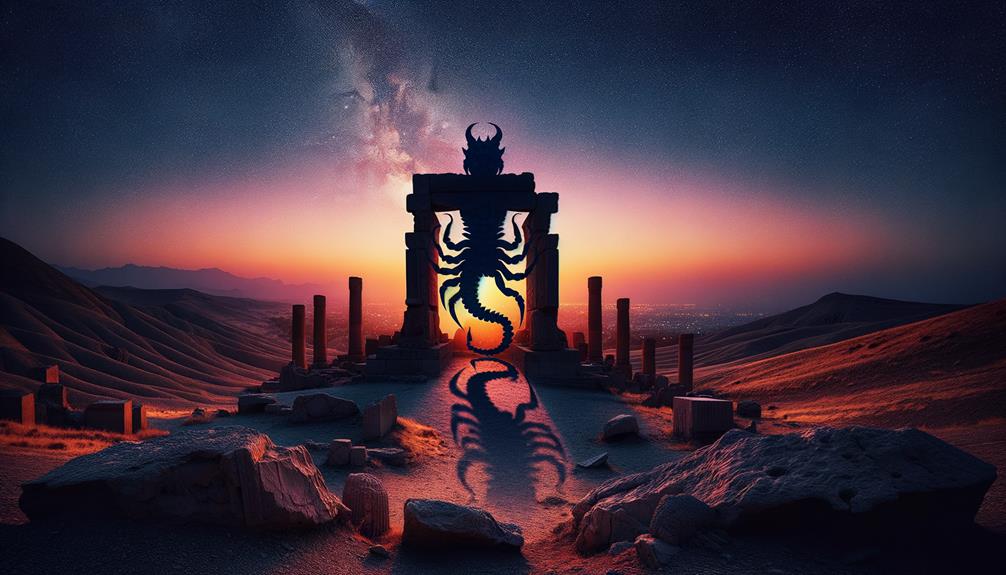
Let's chat about the roots of the manticore myth, a fascinating tale indeed. Interestingly, the word 'manticore' is a descendant of the Latin 'mantichora' and Ancient Greek 'μαρτιχόρας' (martikhórās). These words sprout from an Old Persian term that translates to 'man-eater'. The first mention of the manticore can be found in Old Middle Persian texts, a key period for Persian mythology.
The manticore myth also shows up in the works of Ctesias, a Greek doctor who worked at the Persian court. His writings, along with those of other Greek naturalists, have significantly shaped our perception of this mythical beast. They portrayed the manticore as a terrifying creature from India, equipped with a tail full of sharp spikes it could launch like arrows.
In medieval bestiaries and the History of Four-footed Beasts, the manticore was commonly used as a symbol of evil or danger. Its representation varied from one source to another, mirroring different cultural interpretations. As we continue our journey into Creatures in Mythology, it's exciting to see how the manticore and its related myths have changed over time.
Manticore in Ancient Literature
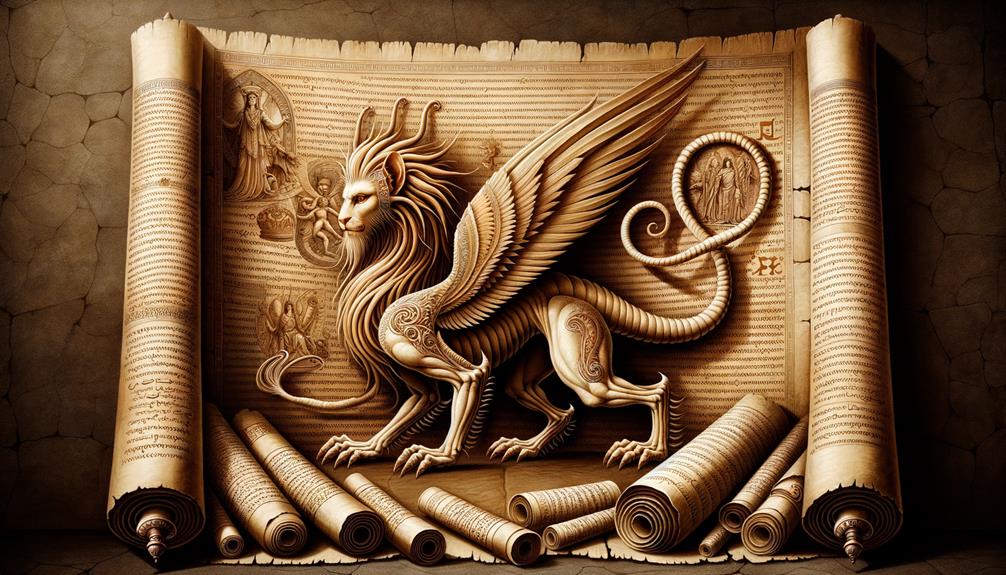
Let's take a look at the manticore, a captivating creature from ancient mythology, and its notable appearances in early literature. To fully grasp the myth of the manticore, we need to examine its depiction in the works of the ancient Greek physician Ctesias, who worked at the Persian court.
Ctesias' descriptions, supported by Aelian's narratives, present the manticore as a terrifying 'man-eater'. The name itself comes from the Ancient Greek 'μαρτιχόρας'. This creature, with its human-like face, bright blue eyes, and vibrant red fur, was thought to have the feet and claws of a lion, along with a venomous tail akin to a scorpion's.
Not just in these works, the manticore also makes an appearance in 'Description of Greece' and 'Life of Apollonius'. In 'Life of Apollonius', a work by Apollonius of Tyana, the manticore is portrayed as a symbol of evil, amplifying its intimidating image. Philostratus, a prominent figure, confirms these portrayals, reinforcing the manticore's lasting appeal in literature and art. Over time, through these literary portrayals, the manticore has evolved from a simple creature of myth to a representation of danger and fear.
Manticore Symbolism and Interpretation
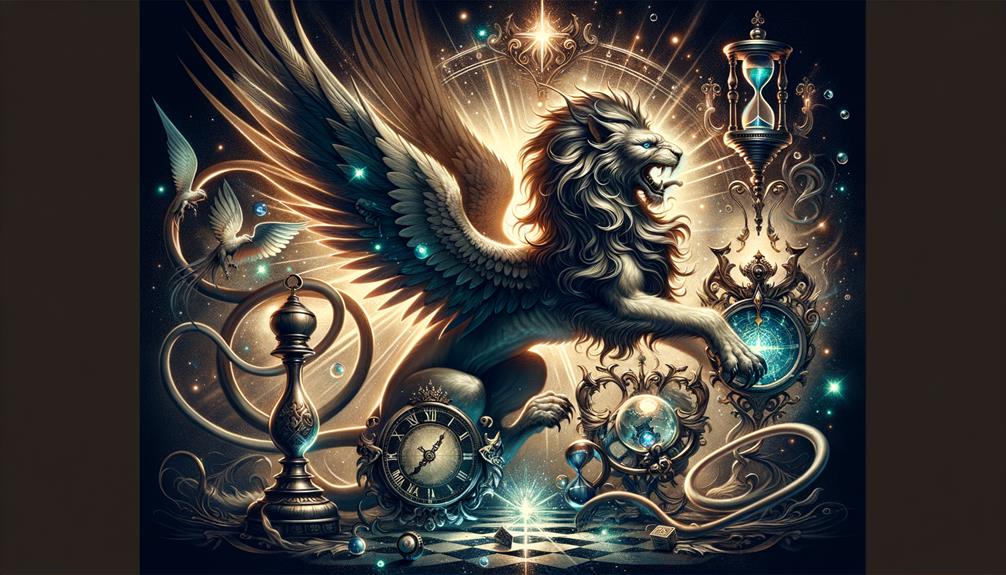
When we consider the manticore's symbolism and meaning, it's obvious that this creature is often depicted as an emblem of evil and peril, especially in ancient and early modern art and literature. The story behind the manticore, as we go further into its depictions, uncovers a savage beast that embodies our fear of the unknown, often linked to the foreign terrains of India.
- The manticore, having a lion's body, a human's head, and a tail like a scorpion, was interpreted as an emblem of the mighty Persian king.
- Greek legends named this beast a man-eater, solidifying its image as a symbol of terror and destruction.
- Its wings, resembling those of a bat, were usually depicted to highlight its otherworldly nature, further intensifying its image as a threatening creature.
- The manticore found a place in Jewish folklore, where it was connected to anti-Semitic propaganda.
- The History Encyclopedia associates the creature with depictions of other dreaded beasts like the African hyena and cheetah, spotlighting a wider societal fear of unknown and foreign entities.
This interpretation of the manticore's symbolism helps us understand how this mythical creature encompasses various historical and cultural fears.
Manticore's Influence in Modern Culture
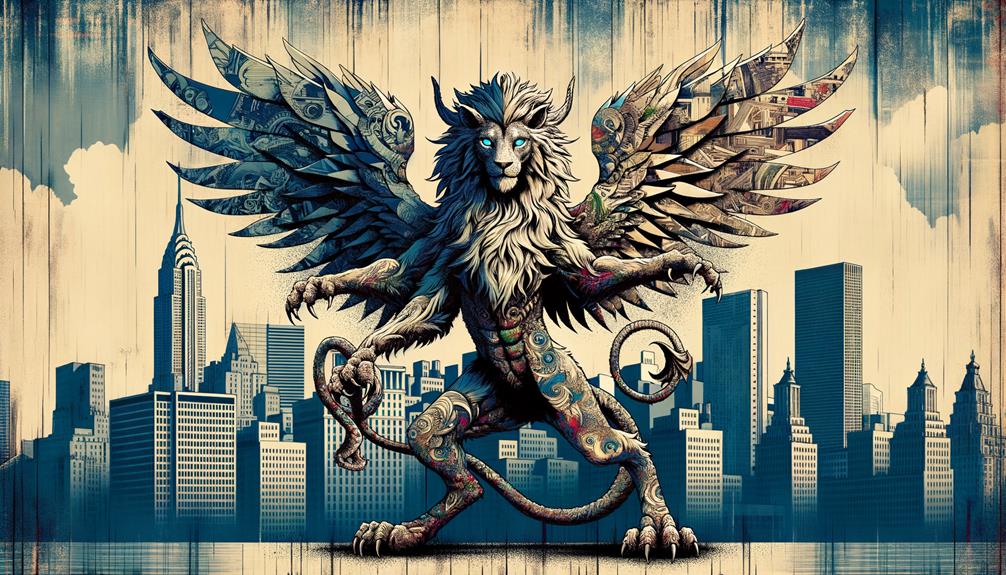
The manticore, a creature from Middle Ages and Early Modern period, has an interesting place in today's culture. It's not just a symbol of fear anymore – in fact, it's become a source of fascination. And you can see this shift clearly in fantasy literature and role-playing games. The manticore is no longer just a scary creature; it's now a main character that inspires both fear and curiosity.
Ctesias, a Greek historian, was one of the first to talk about the manticore myth. Nowadays, we see modern writers putting their own spin on his stories. Take Salman Rushdie's 'The Satanic Verses,' for example. Published by University Press, this book features the manticore in its first chapter. And it's not just in books for adults – the manticore also appears in J.K. Rowling's Harry Potter series.
Even in more gentle stories, like E. Nesbit's 'The Book of Dragons,' the manticore still holds a special place. In this book, published by the Church of St Mary, the manticore is portrayed as a gentle creature.
This shift in how the manticore is depicted shows just how adaptable it is. It's not just a symbol of fear, but also a figure that inspires the imagination. And this just goes to show how powerful the manticore is in our cultural consciousness.
Frequently Asked Questions
What Do Manticores Symbolise?
Manticores, these creatures of myth, are often seen as a sign of something bad on the horizon, just like the ominous clouds that signal an incoming storm. They're symbols of fear and bias, typically used to represent those things that are strange or foreign to us. Even in today's fantasy tales, the manticore's reputation for savagery and evil nature persists.
What Are Three Interesting Facts About Manticore?
You won't believe how intriguing manticores are! These mythical beasts come from Persian lore, where they're often referred to as 'man-eaters'. Picture a creature with a human face, the body of a lion, and the tail of a scorpion – pretty scary, right? And if you're a fan of Harry Potter, you might recognize these creatures from the series!
Is a Manticore Good or Evil?
So, you're wondering whether a manticore is good or evil, right? Well, here's the deal. A manticore isn't necessarily one or the other. Sure, it's often depicted as a terrifying beast, but that doesn't automatically cast it as evil. It all comes down to how the myth is interpreted, and that's what shapes its moral standing.
Why Is the Manticore Feared?
So, why do people tremble at the mention of the manticore? Well, this mythical creature is notorious for its lethal traits such as its venomous sting, not to mention its rather unsettling taste for human meat. Not helping its case, it's often portrayed in medieval art and literature as an embodiment of evil, which only amplifies the fear factor.

